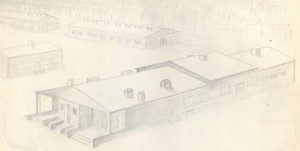
Left idle throughout the fall of 1943, Tunnel “Harry” by Feb. 23, 1944, has been reactivated for six weeks. The Escape Committee had decided to institute the autumn digging hiatus because the German anti-tunnelling guards (“the ferrets”) had discovered the Tunnel “Tom” in September. So POWs at Stalag Luft III calculated, by calling a halt to tunnel excavation, they could lull the compound guards into believing they’d nipped the kriegies’ tunnelling efforts in the bud.
However, when work on “Harry” began again in January, a new problem loomed. Previously, “penguins” (POWs packing excavated sand down their pant legs and dispersing the yellow excavated sand into white surface sand) had “disappeared” the sand out in the compound. But with winter snow on the ground, there was no place to hide “Harry’s” deposits.
The air officers of X Organization (the escape committee) hit on a new repository for the sand. The North Compound theatre – built in the summer of 1943 – had a different structure than most buildings in the compound. It wasn’t built on stilts like the barracks huts. It had a bricked in, enclosed basement.
And beneath the raked floor boards of the main theatre lay a beckoning space … room for whatever excavated sand “Harry” could deliver. In addition to the regular carpentry work that went into weekly productions staged at the theatre, crews installed a hidden trapdoor at seat 13 in the 300-seat theatre. That trap would allow penguins to unload even more sand, more quickly and less conspicuously into the basement of the theatre.
“The theatre was a lifesaver,” one Stalag Luft III POW said. While the kriegies staged Shakespeare and Shaw on the proscenium stage in front of audiences that included German officers, beneath the raked floor of the theatre, excavated sand from “Harry” was packed into every nook and cranny. Eventually, 30-50 tons of sand was stashed beneath the most popular location in the North Compound.